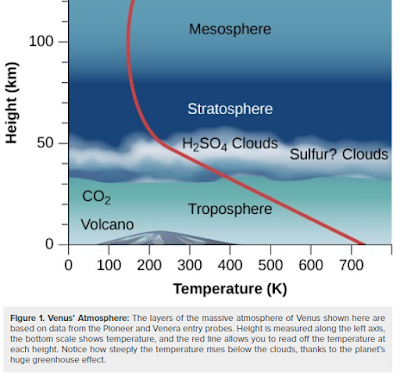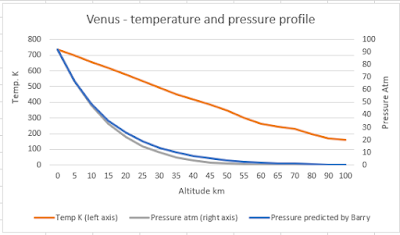... we grappled with the maths
And then we knew that CO2 is
Not a 'greenhouse gas'
Many people over-egg the Venus pudding. From here:

Read it and weep: "Notice how steeply the temperature rises below the clouds, thanks to the planet's huge greenhouse effect."
Well, having looked into all this in reasonable depth over the past few weeks, I notice no such thing. "Steeply rising from the clouds down" is the same as "steeply falling from the ground up", which it clearly doesn't.
The chart shows a lapse rate of about 10 K/km up to 50 km altitude (although the true figure is a bit less than 8 K/km, see below), which is not much more than on Earth's average moist lapse rate actually measured, which is 6.5 K/km ('should be' nearly 10 K/km, but water and water vapour moderate it by one-third, there's little to no water vapour on Venus to moderate it there).
So let's apply the same basic physics to Venus' atmosphere as we did to Earth's and see if we can reconcile it all.
What would we expect the lapse rate to be? Remember, T/h = g/cp.
Gravity on Venus is 8.87m/s2
Specific heat capacity of CO2 at 700K = 1,126 J/kg/K
So lapse rate should be about 7.87 K/km.
Wiki provides more precise figures for the vertical temperature and pressure profile.
Temperature at 0 altitude = 735 K, at 60 km = 263K.
(735 - 263)/60 = 7.87 K/km
That's a good match! (It might seem like fudging to use specific heat capacity at hard-surface temperature, but that's the one you have to work out; it stays pretty constant above that until you are above 99% of the atmosphere).
The Barometric Formula also works pretty well:

Right, next questions
a) what is the 'effective temperature' of the surface of Venus
b) what is the 'surface'
c) what is the actual temperature at the 'surface'
d) what would we predict the temperature of the hard surface to be
e) does our prediction match the actual temperature of the hard surface
a) There is a nice table at the end of this article showing that the 'effective temperature' (expected temperature based on incoming sunlight and assuming no atmosphere but that albedo stays as it is) of Venus should be 232K.
b) What is the 'surface'? If we are looking at 'effective temperature', we should be looking at the 'effective surface' to match, which is whatever the sunlight hits first. Venus has thick clouds between 50 km and 80 km altitude, going by Wiki's more reliable figures. These clouds are very thick/white, which is why Venus has an albedo of 0.75 (0 = black, 1 = white). The 'effective temperature' is based on the albedo of those clouds and that's what the sun light hits first, so the 'effective surface' is the self-same clouds at (say) 70 km altitude.
c) And what is the actual temperature at 70 km altitude.? [Drumroll...] It's 230 K, so a very good match between actual and prediction.
d) With that as the starting point, we can predict the surface temperature, being
232 K 'effective temperature' at 'effective surface' (70 km altitude)
plus 10 km x 3.3 K/km (actual lapse rate between 60 km and 70 km)
plus 60 km x 7.87 K/km (predicted/actual lapse rate for altitudes below 60 km)
= 737 K.
e) [Drumroll...] The actual surface temperature is given as 735K [Cymbal]
-----------------------------------------------------------
Some bonus comparisons while we've got the facts at our finger tips:
1. On Venus, at 50 km altitude, atmospheric pressure is 1.066 atm, in other words, similar to average Earth sea-level pressure; and the temperature is 348K.
Venus gets 662 W/m2 solar radiation, Earth gets 342 W/m2 radiation.
Given those facts and figures, what would we predict Earth's sea-level temperature to be?
348K ÷ ((662 W/m2 ÷ 342 W/ms)^0.25) = 295K.
Earth's average sea-level temperature is given as 288K, so we are in the ballpark.
2. On Venus, at 79 km altitude, atmospheric pressure is 0.006 atm, the same as the pressure at Mars' hard-surface level; and the temperature is 200K.
Mars' average hard-surface level temperature is 215 K. Mars and Venus both have atmospheres that are about 95% CO2, so the amount of CO2 above 80km altitude on Venus and above hard-surface level on Mars is going to be about the same. Venus' atmosphere at that altitude should be far warmer than Mars' hard surface temperature (Venus is a lot closer to the Sun) but we simply don't know why there is a discrepancy here.
3. Yes, you read that correctly, Mars' atmosphere is 95% CO2, but according to Wiki, "The average surface emission temperature of Mars is just 215 K, which is comparable to inland Antarctica. The weaker greenhouse effect in the Martian atmosphere (5 °C, versus 33 °C on Earth) can be explained by the low abundance of other greenhouse gases."
Hang about one cotton pickin' moment here, there isn't much by way of 'other greenhouse gases' on Venus either! What are these mysterious 'other greenhouse gases' anyway?
4. By mass, there is about twenty-five times as much CO2 per m2 of Mars surface than on earth.
Mars: 620 Pascal hard-surface pressure/3.77 m/s2 gravity = 164 kg, x 95% = 156 kg CO2/m2.
Earth: 101,325 Pa/9.807 m/s2 gravity = 10,332 kg, x 400 ppm = 4.13 kg, scaled up by 40/29 because CO2 is heavier than usual N2/O2 mix = 6.3 kg CO2/m2.
156 kg/6.3 kg = 25.
But there's barely any 'greenhouse effect' on Mars... because reasons?
